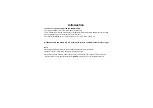
OBEX Formats
209
vEvent Object
Decription:
This is a definition of the vEvent object, which is related to the vCalendar
object. These objects are used when a user-defined calendar entry is
exchanged. The phone supports all day event meetings. The sync engine shall
send the vCalendar object with DTSTART, set the date (YYYYMMDD), and
leave the time 'THHMMSS' out. The DTSTART is mandatory, as well as the
DTEND. The same principles applies for DTEND, that is, 'THHMMSS' is
skipped.
Syntax:
<vevent-object>
"BEGIN:VEVENT"<CR>
"DTSTART:"<date_and_time>
"DTEND:"<date_and_time>
"AALARM:"<date_and_time>
"CATEGORIES:"<category>
"SUMMARY;"<encoding>";"<character_set>":"<summary>
"LOCATION;"<encoding>";"<character_set>":"<location>
"X-IRMC-LUID:" <x_irmc_luid>
"END:VEVENT"
Parameters:
<date_and_time>:
String; <year><month><day>T<hour><minute<second>.
The date and time values for all vCalendar properties are formatted as a string
consistent with the ISO 8601 representation for combinations of dates and
times.
Note: All time values are given in local time.
Example
<date_and_time>:
19960415T083000. 8:30 AM on April 15, 1996 local time.
<category>:
"MEETING" | "PHONE CALL" | "MISCELLANEOUS"
<encoding>:
("QUOTED-PRINTABLE" | "BASE-64" | "8BIT")
<character_set>:
("ISO-8859-1" | "UTF-8")
<summary>:
String; maximum length 36 bytes.
<location>:
String; maximum length 20 bytes
<x_irmc_luid>:
String; maximum length 12 bytes. IrMC Local Unique Identifier field label. Local
Unique identifier 48 bits coded in its hexadecimal representation as 12 ASCII
characters. Holds the phone book index in decimal format.
Example
DTSTART-DTEND:
DTSTART:1999-02-10, DTEND:1999-02-12.
If the DTSTART and DTEND have different dates, the phone shall interpret it as a
whole day event occurring over several days.
In this example: the whole day on 1999-02-10, 1999-02-11, and 1999-02-12.














































